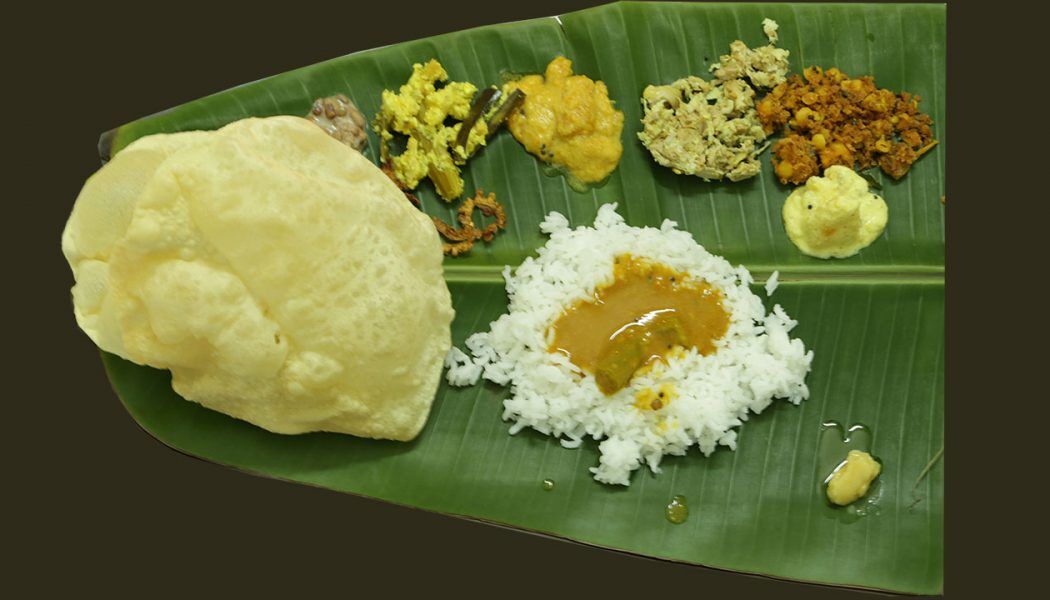The Traditional Kerala Sadya is a feast of Vegetarian Cuisine. Sadya is served on various occasions like Birthdays, Cultural Festivals like Onam and Vishu as well as Marriages. Traditional occasions in Kerala is always celebrated with Sadya.
A typical Sadya can have 24 or more items and served on a plantain (Banana) leaf called the “Thooshan Ila” of about one and a half feet long. The items include boiled red/white rice, main and side dishes, pickles, savouries, desserts, banana, ghee, dal etc. The tapering side of the plantain leaf is placed pointing to the left side of the person sitting in front of it. Items are arranged on the top and left sides of the leaf before one sits in front of it.
Arrangement of items and importance of Sadya
Traditionally, there is a specific order in which items are arranged and served on the leaf. These items are selected in such a way that the person enjoys the taste and spiciness of the food and also importantly how it gets digested. As per Ayurveda, the Sadya is dominated by the basic tastes of Sweet, Bitter, Sour, Salty, Spicy and Umami (Savoury taste) and is a completely balanced meal. Fresh Banana leaf enhances the flavour of the delicacies served hot on it.
The person having Sadya should sit on the floor in the “Ardha Padmasana” (half-lotus pose in Yoga) which helps the digestion process. It is said that the dishes served from the left to right of the leaves should be eaten in the opposite direction. The lower portion of the leaf is for serving Rice (and later Payasam), which is served only after the person sits in front of the leaf.
Basic Order of having Sadya
A small portion of rice is kept aside on to the right side over which the Parippu (Dal) and Ghee are served. Sadya starts with eating this along with Pappadam. No other curry or dish is used along with it. This is basically for the lubrication and to help proper digestion of the food.
Next is Rice and Sambar – Sambar is the main dish with gravy unlike other side dishes which are generally slightly dry compared to Sambar. Small balls are made of Rice and Sambar and taken in. After having one or two balls of Rice and Sambar, one starts with the Side dishes starting from the right side of the leaf. One can have Pappadam and Chips along with it and also have the pickles to taste. Sadya is enjoyed to its fullest when items are properly chewed and taken in. This helps proper digestion of food.
Rasam which is basically a thin and spicy soup made of Dal (Parippu), Tomato and Masala is served next. Some prefer drinking the Rasam in glass but traditionally it is taken along with rice.
Payasam – Sweet
An important item in the Sadya is the Payasam which is prepared either with Sugar or Jaggery. Various Payasams are served on a Sadya but most importantly it will be the Palada Pradhaman which is made of Milk (Paal), Rice (Ada) and Sugar. Normally there will be one Payasam with Milk and Sugar (Palada Pradhaman) and second one with Jaggery and Moong Dal (Parippu Pradhaman) served on a Sadya. Banana (Pazha Pradhaman), Jack Fruit (Chakka Pradhaman) are also served according to the choice of the person organizing the Sadya. It is normally after the Rice and Rasam we take the Payasam but entirely depends upon the person.
Next, we have the Rice and Curds/Butter Milk (Laban) served which nullifies the negative effects of having spicy and sugary food that we have taken in. Acidity is minimized by consuming Rice with Curds or Laban. Finally to end the feast, one eats the small banana served on the leaf. This also helps in proper digestion of the food.
Avoid drinking water in between, while having the Sadya – which fills your stomach easily and you many not be able to enjoy the sumptuous food. You can drink water at the end of it but preferably not in between.
Common Items for a Sadya
Here are the most common items served on a Sadya. You may have more items and it can go up to 101 items (depends upon one’s imagination and creativity). The size of the Banana Leaf also goes longer as we have more items. The items may change from place to place within Kerala.
- Rice
- Sambar
- Rasam
- Dal and Ghee
- Kaalan
- Olan
- Stew
- Aviyal
- Thoran
- Pineapple Pachadi
- Kichadi
- Pappadam – Big and Small
- Chips – Banana (4 Cut and Jaggery), Yam, Bitter Gourd
- Puli-Inchi
- Pickle – Mango and Lime
- Small Banana
- Payasam – Palada Pradhaman and Parippu Pradhaman (or alternative)
- Curd or Butter Milk
- Salt
- Water
Oh dear, I feel like having a Sadya now. What about you?. The items and taste changes as we go from North to South and East to West of Kerala. But the Sadya is always filling and ultimate. Next time, when you celebrate a function, try to do it as a traditional Kerala Sadya and I am sure you will enjoy it.
